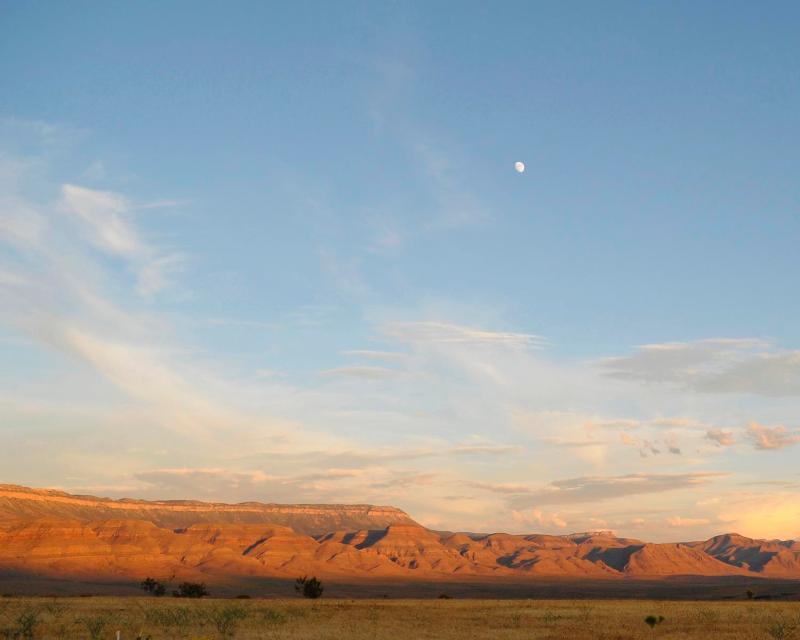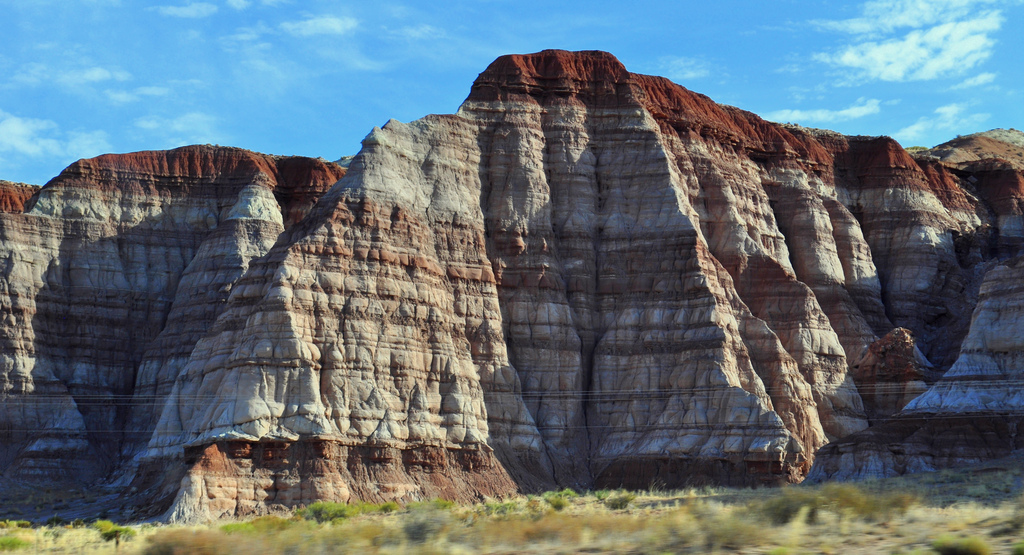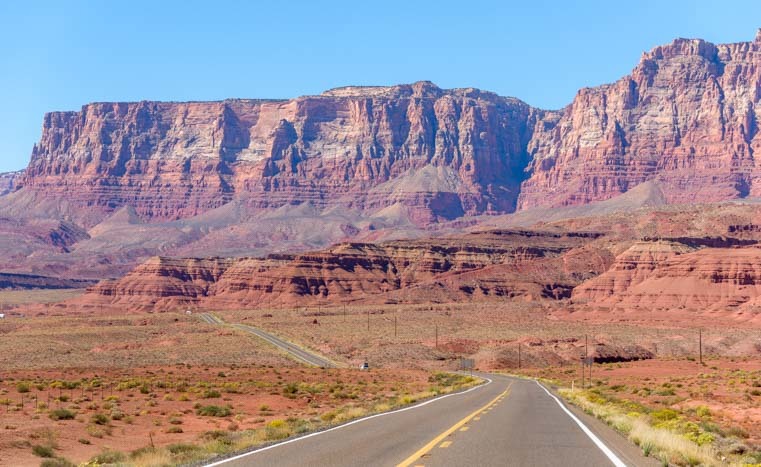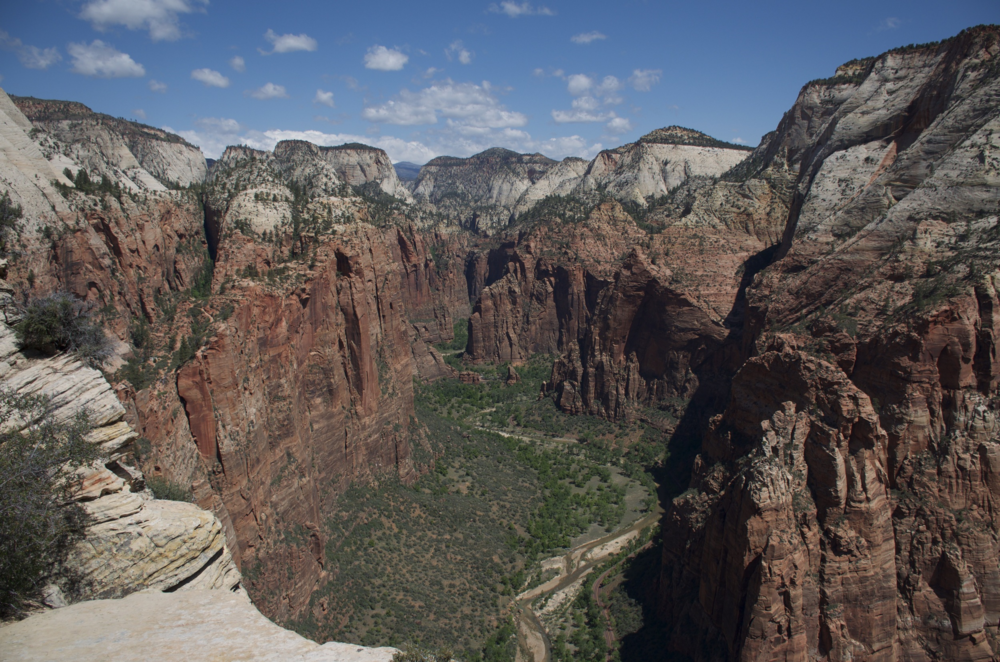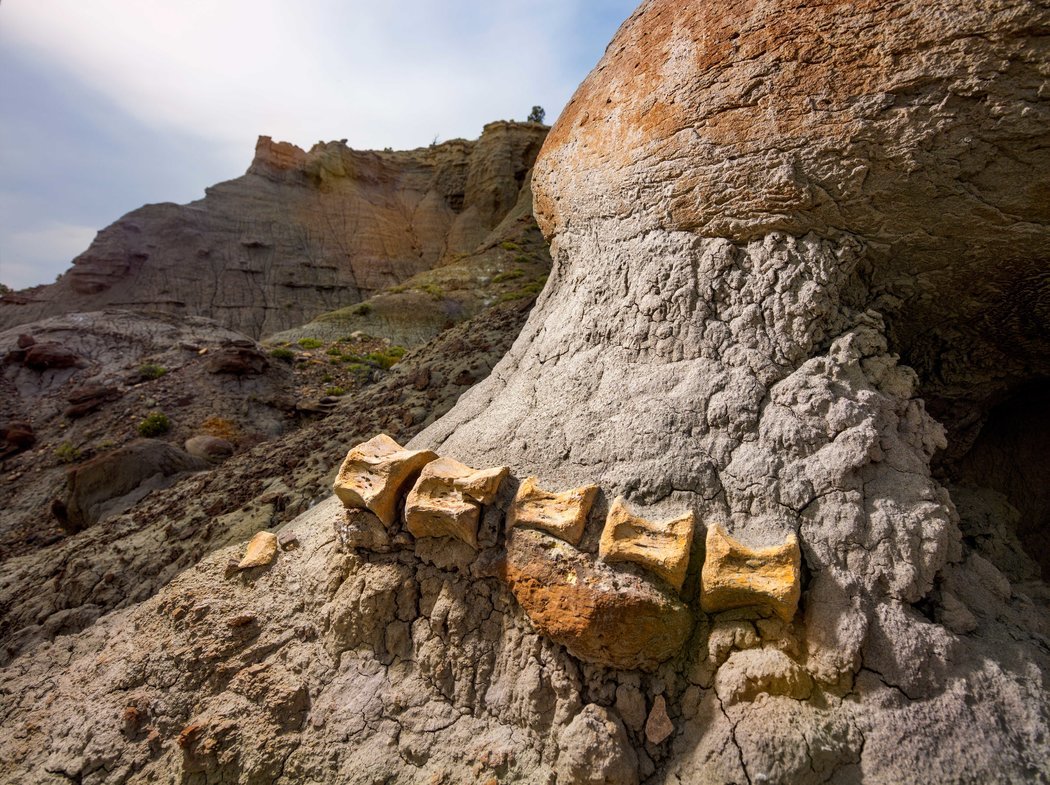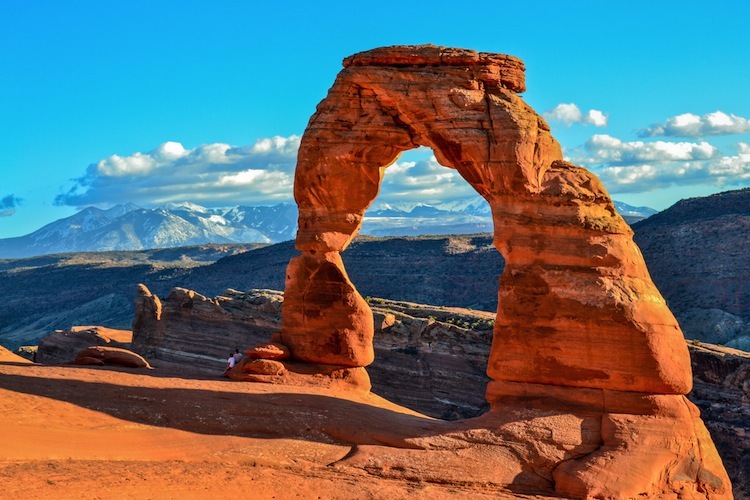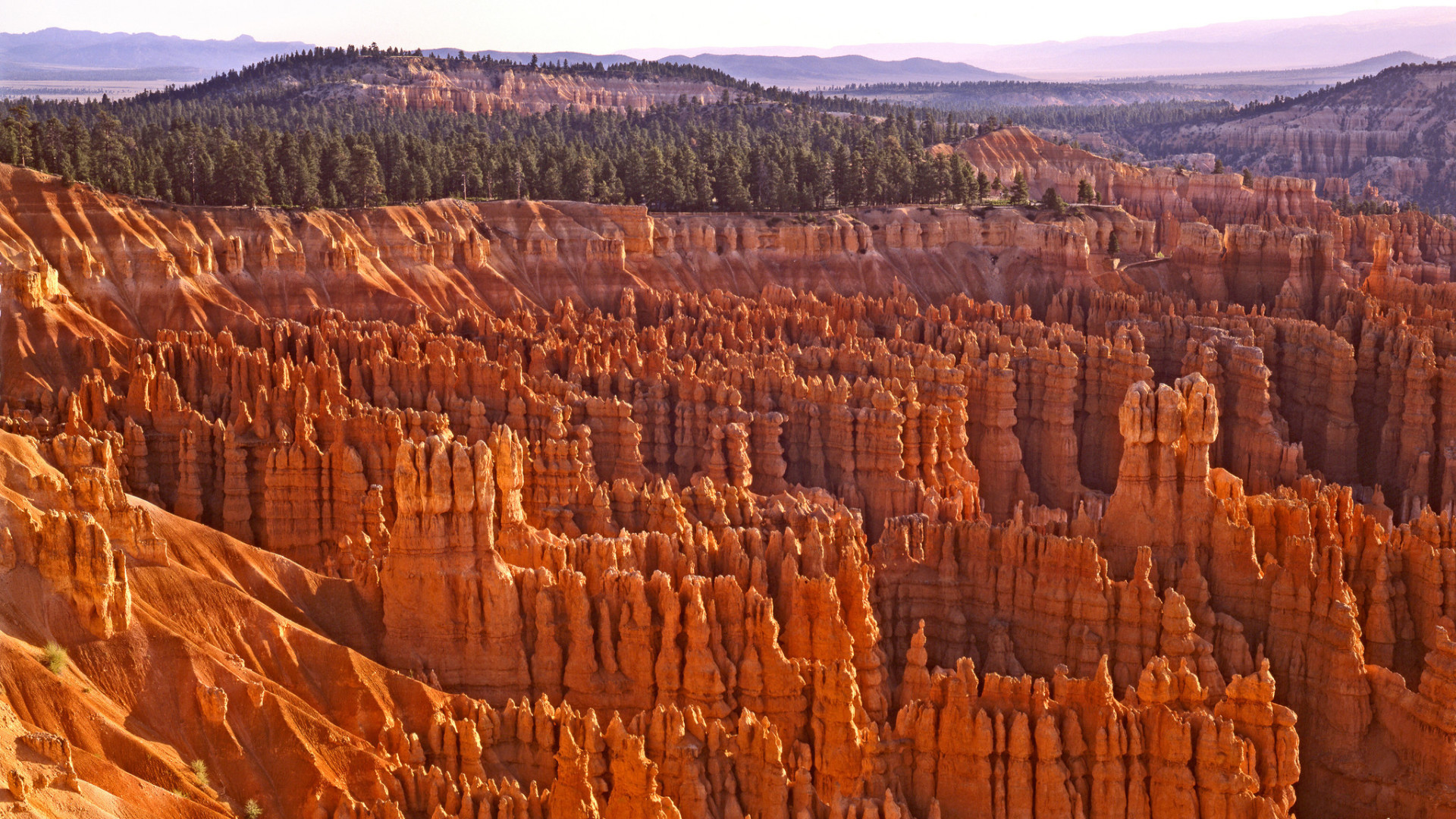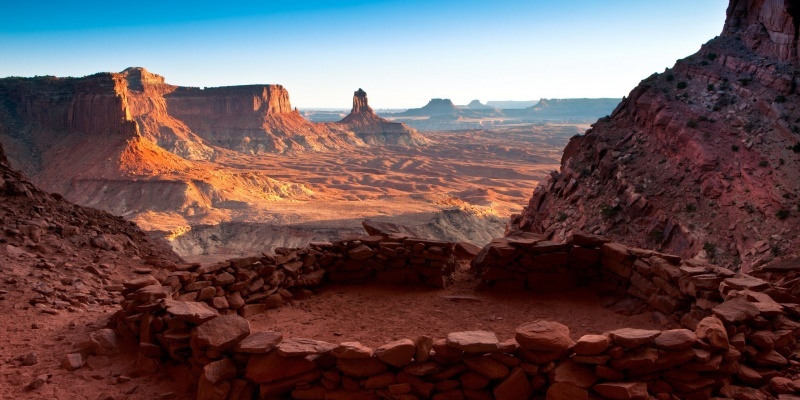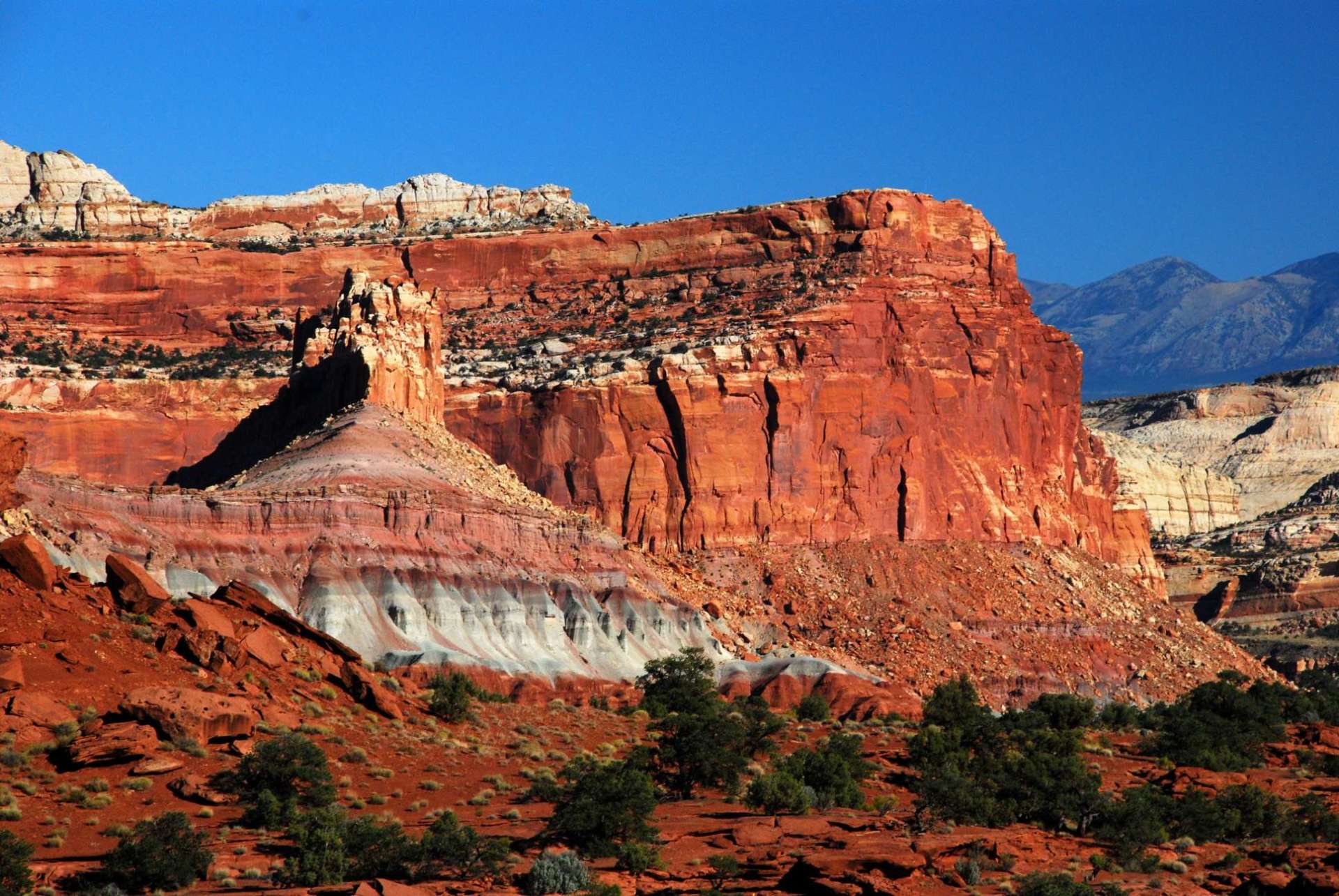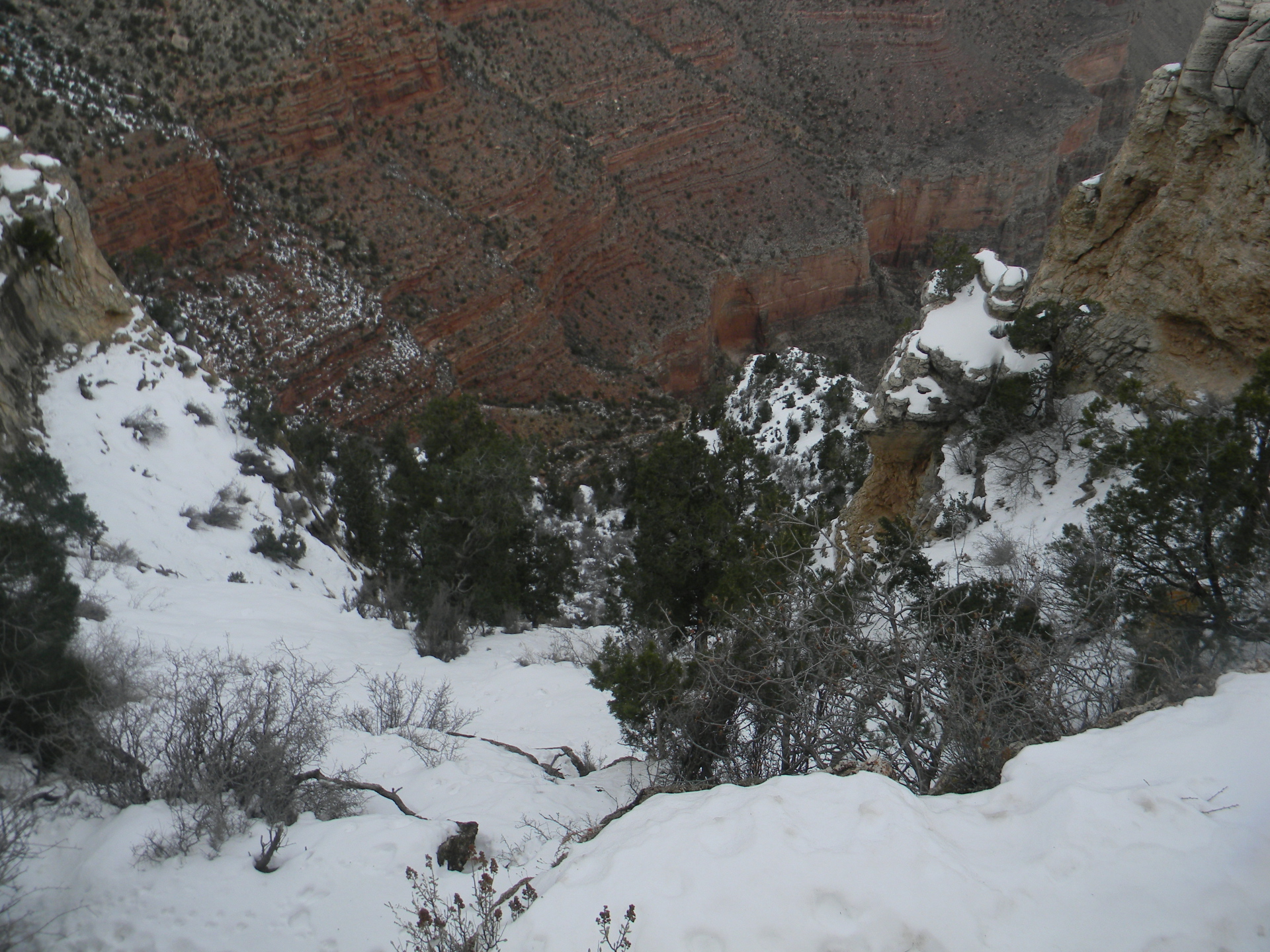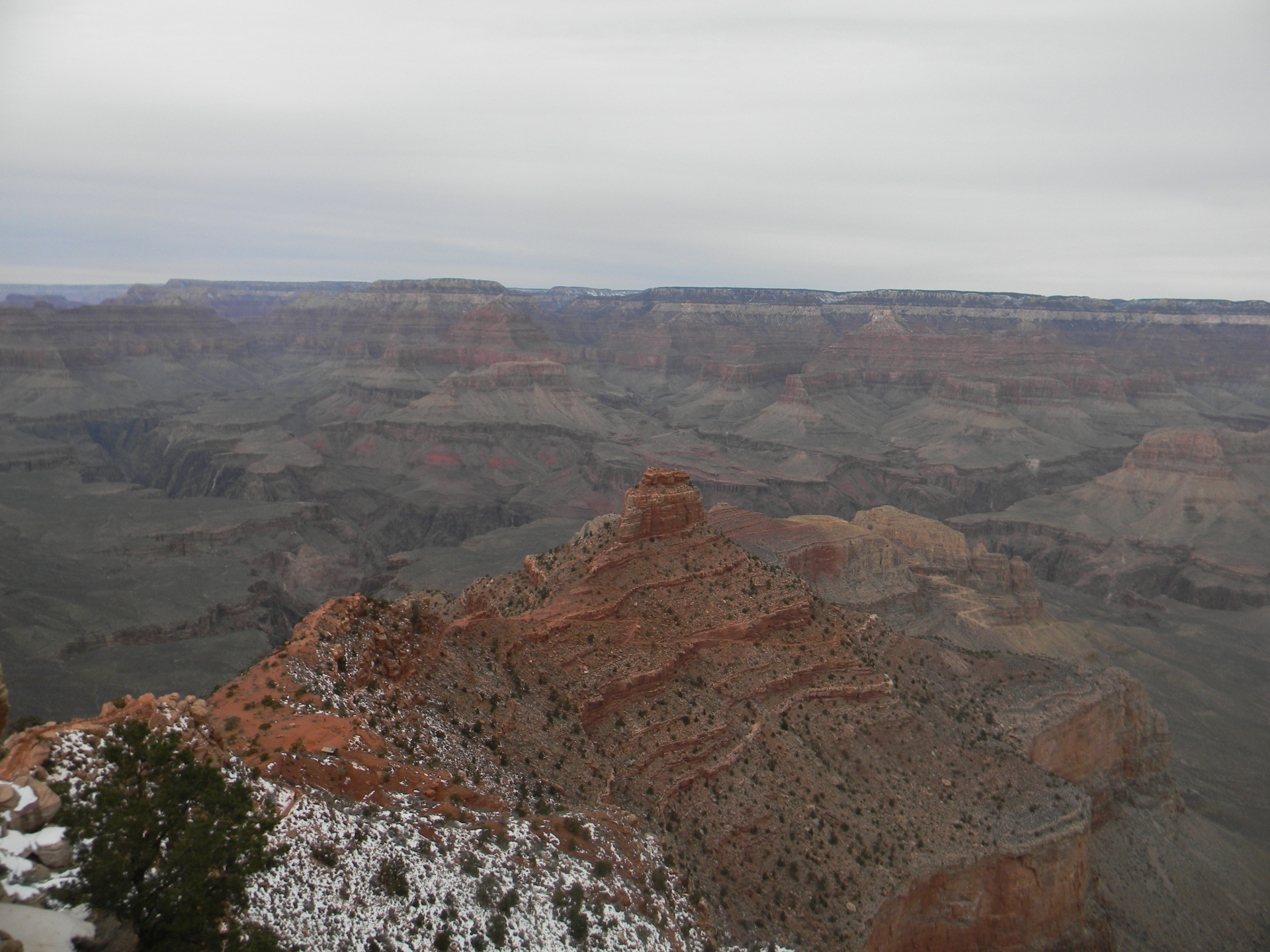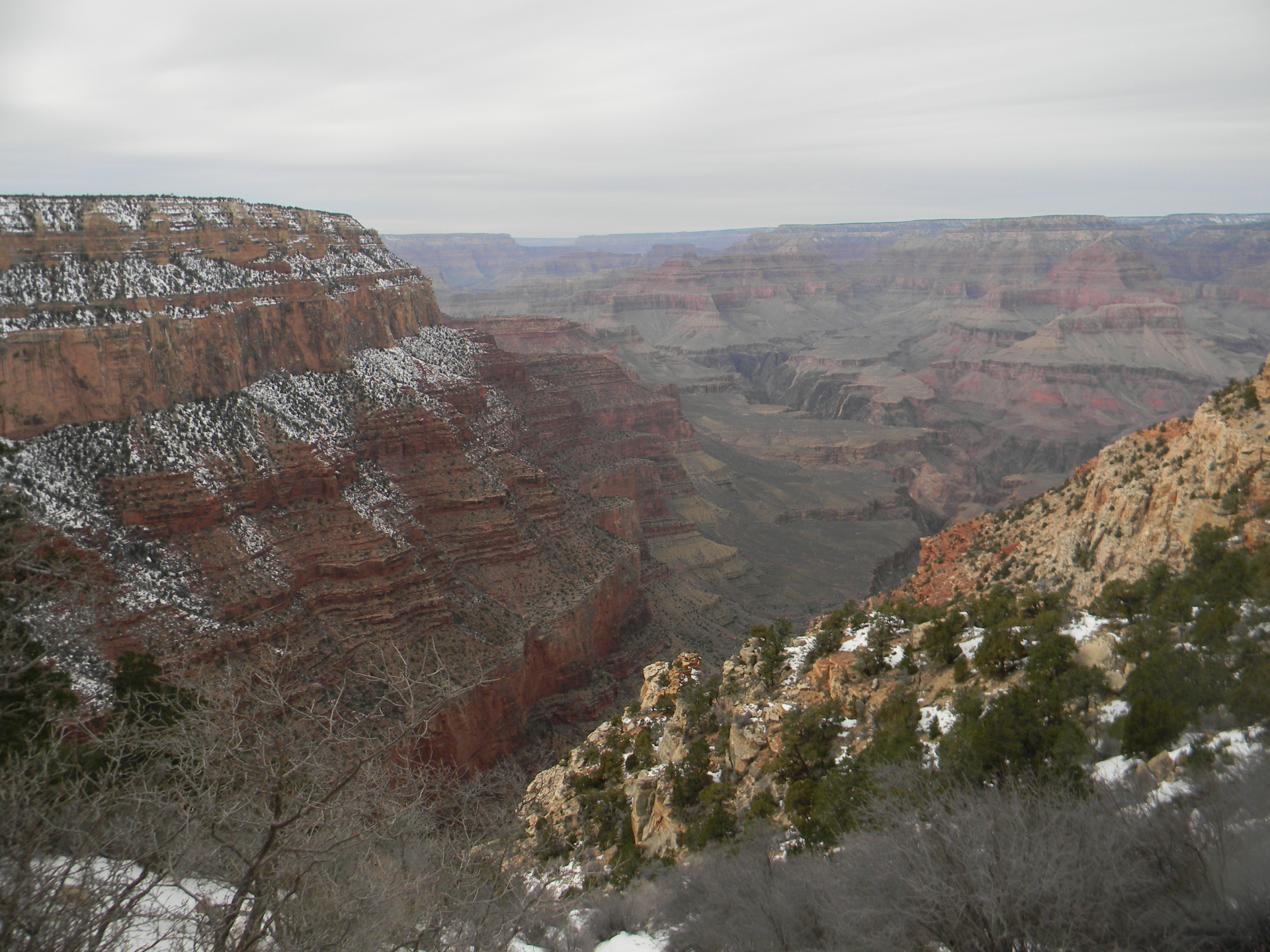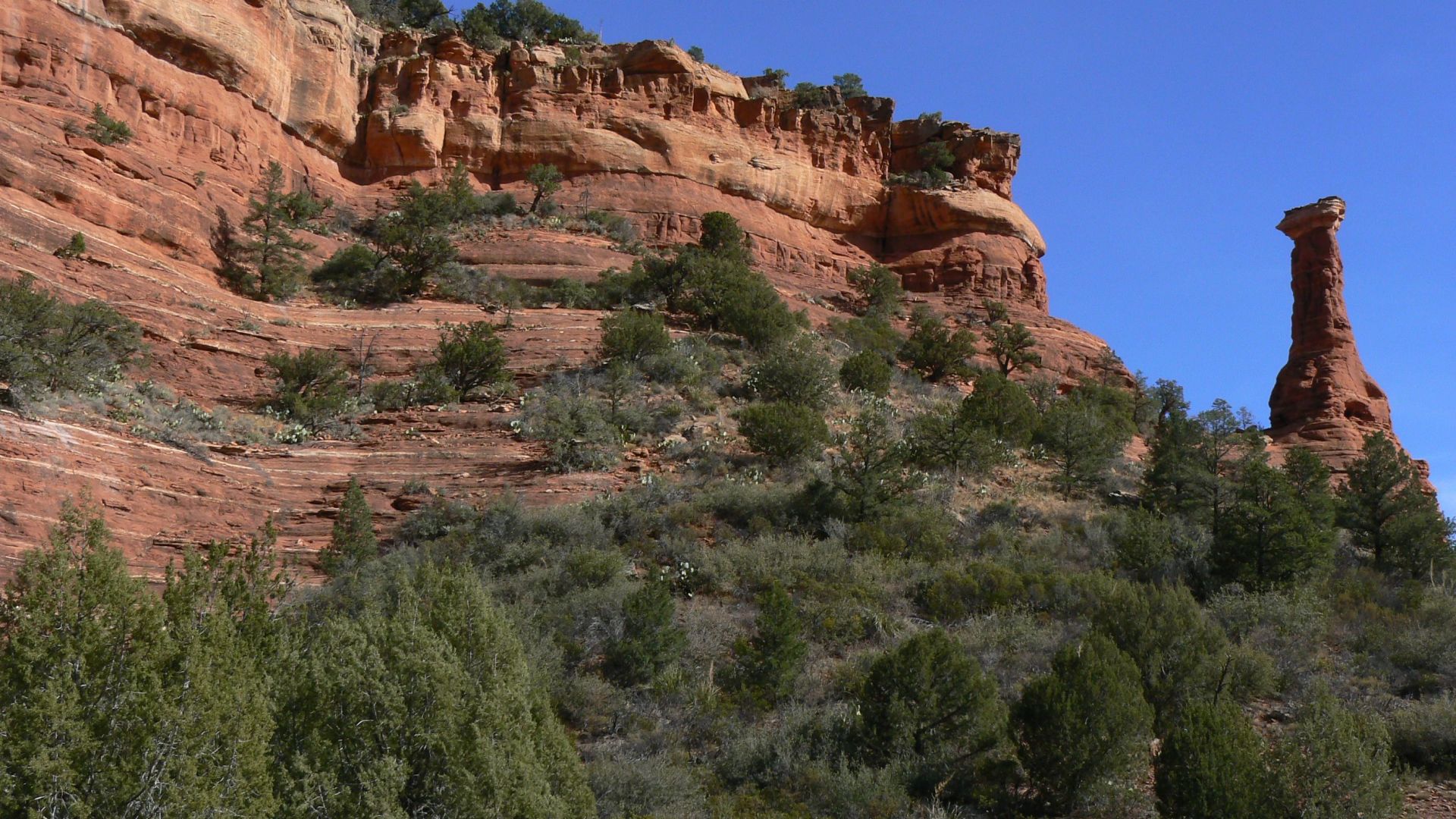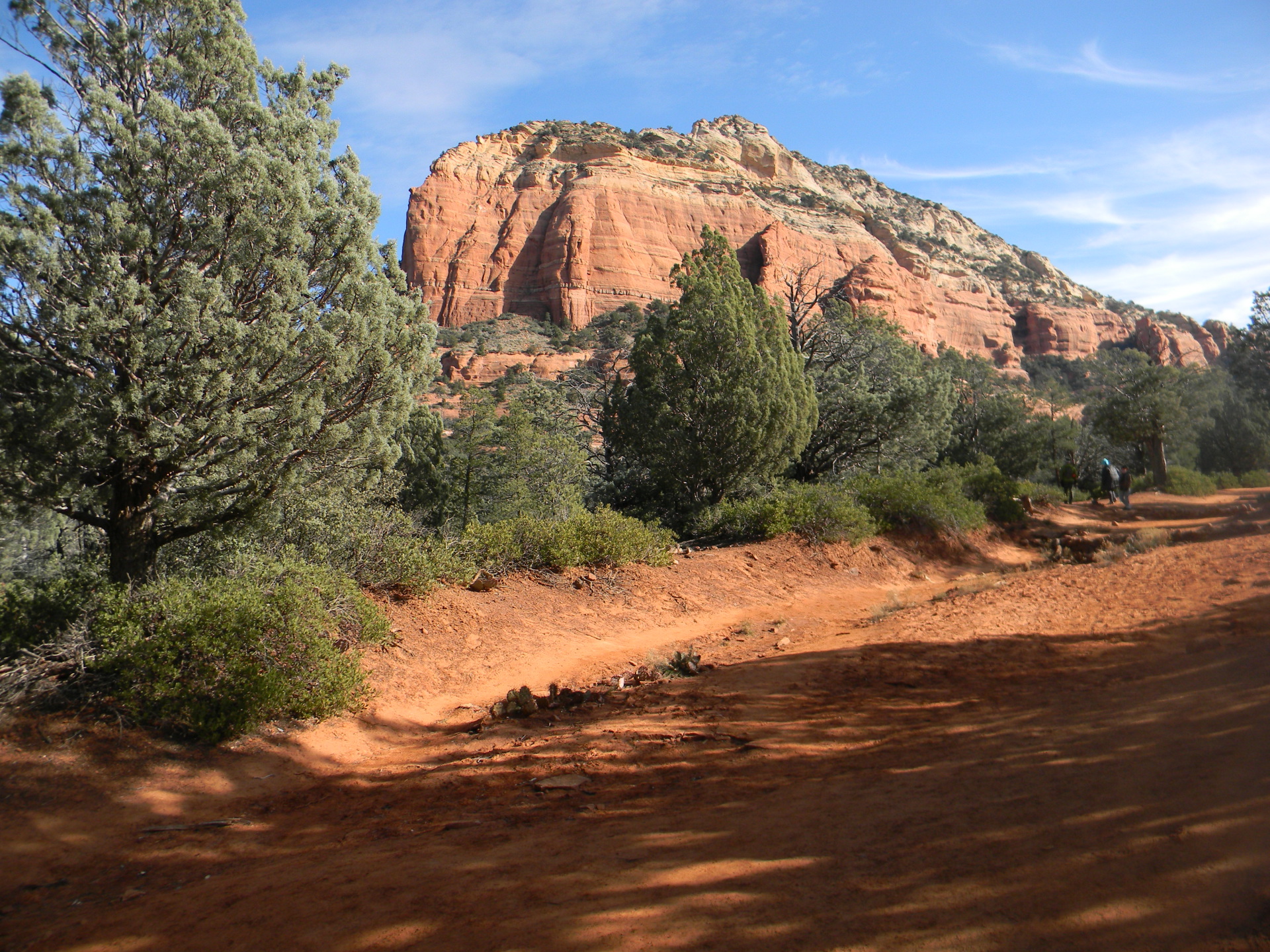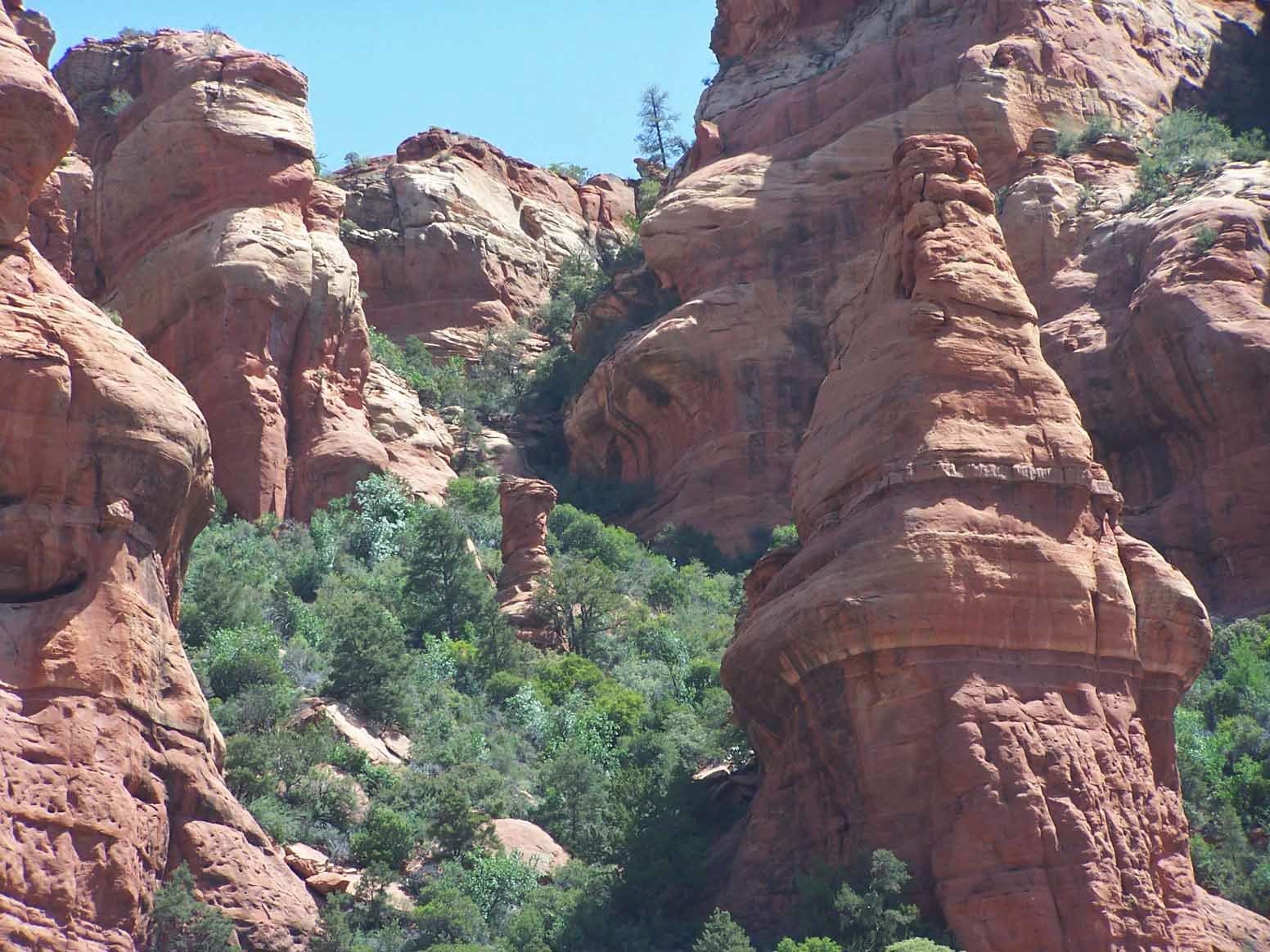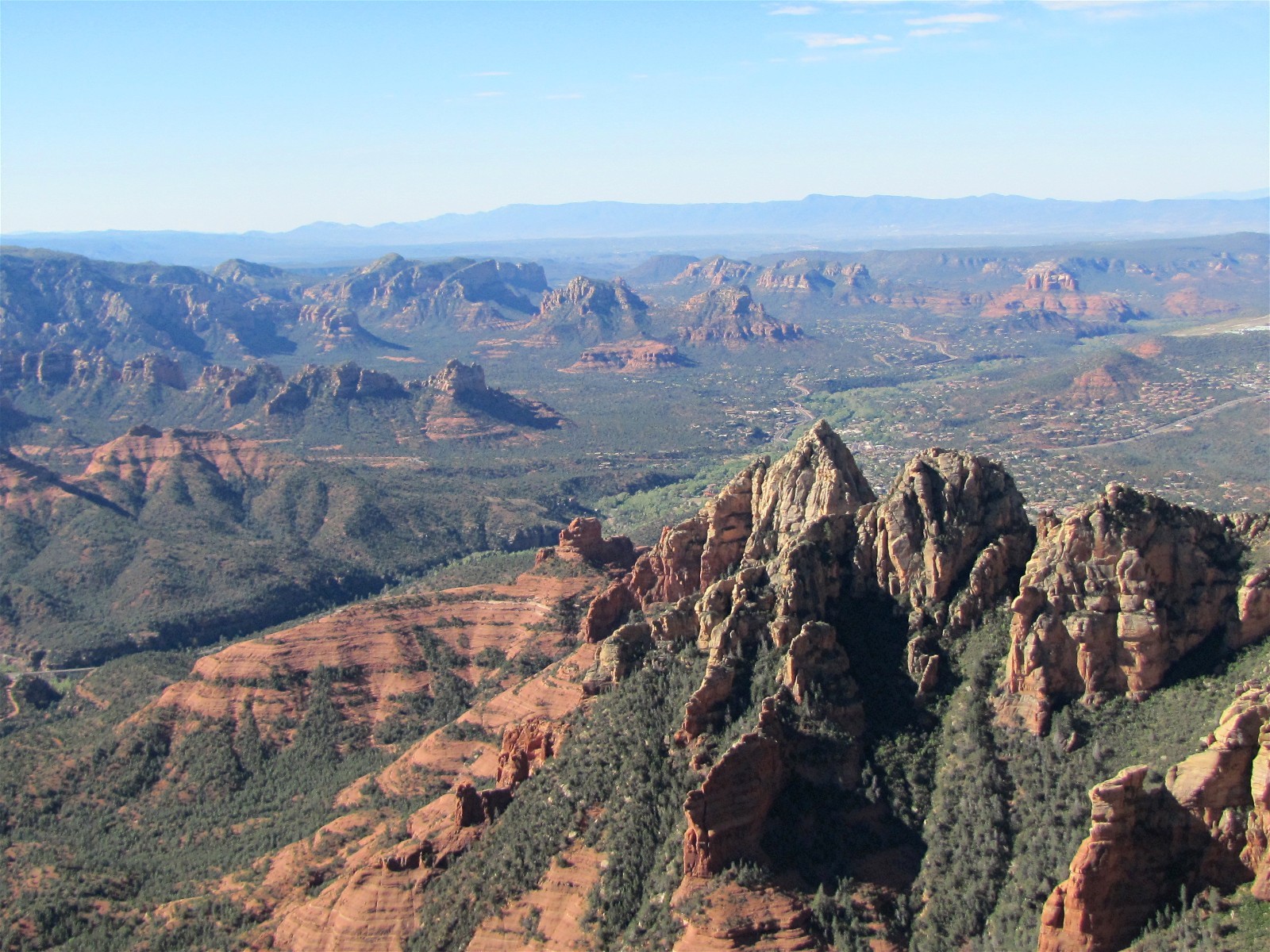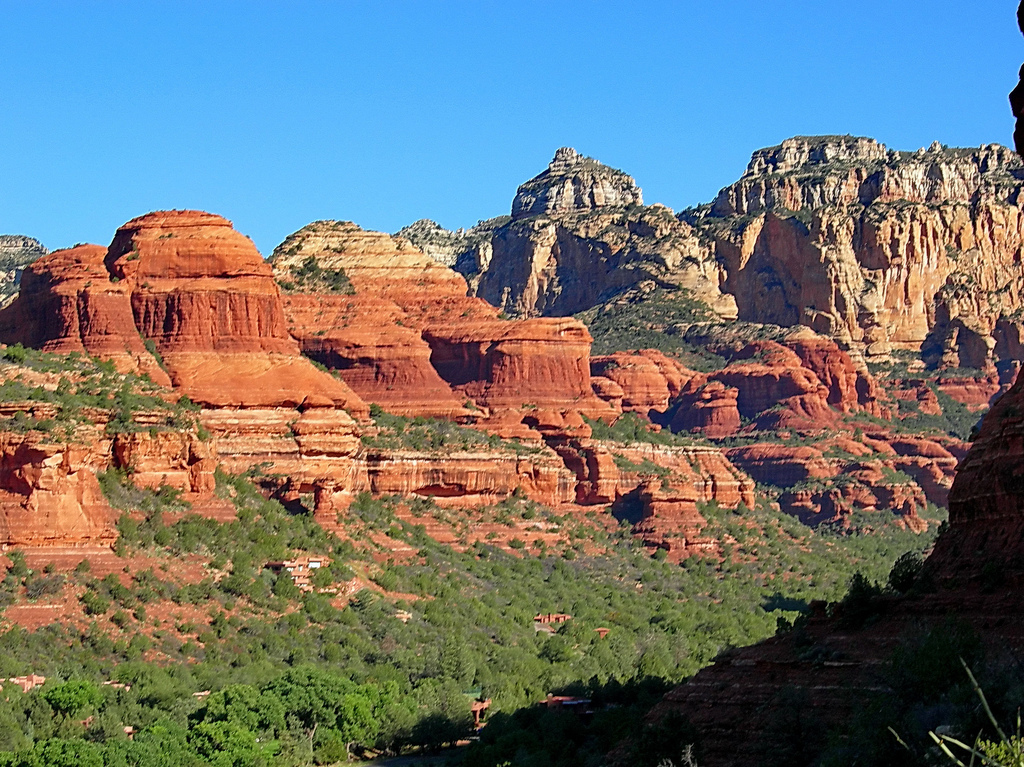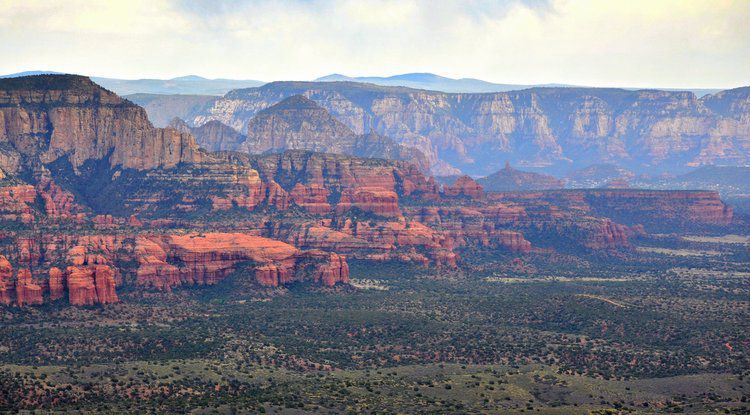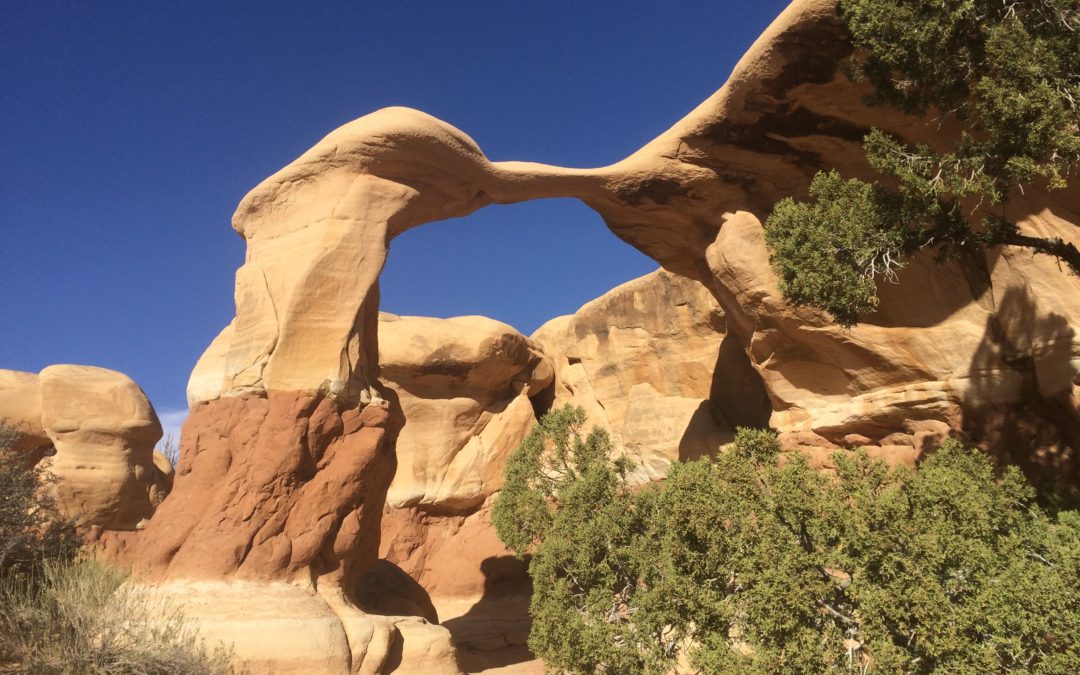
by The Goat | Aug 27, 2019 | Geology, Grand Staircase-Escalante, History, Utah Canyon Country, Vermillion Cliffs
How was the Grand Staircase formed?
Why is the Grand Staircase called the Grand Staircase? Because it sounds cool? Well, of course because it sounds cool, but the name actually represents a very unique and important geological phenomenon that has been built over hundreds of millions of years. Starting from the North Rim of the Grand Canyon to the hoodoo wonderland that is Bryce Canyon National Park, the Grand Staircase represents progressively younger and higher cliffs that quite literally form a staircase, as though a giant was looking for an easy way to step up to the Sierra Nevada Mountains. There are five stairs in this grandest of staircases, each a different color, a different piece of rock, and a different age from Permian to Cretaceous, a span of over 200 million years.
Step Zero: Kaibab Limestone, North Rim Grand Canyon National Park
Before you being to climb any staircase, you must first stand below it and contemplate your climb. This is step zero. The best part about this step is that there it also serves as a foyer, with stairs above and below. The stairs below? 2 billion years of Earth’s history and 5000 vertical feet down to the Colorado River and its Grand Canyon. The top step of this staircase is the North Rim of the Grand Canyon and the Kaibab Limestone, a Permian formation packed with marine fossils that serves as the hard, protective layer of the Kaibab Plateau and the soft sandstones and shales that make up the red and orange walls you will see when hiking in Grand Canyon
Step One: The Chocolate Cliffs: Moenave and Chinle Formations
The first official step in the Grand Staircase is the Chocolate Cliffs, located near the town of Fredonia, AZ and seen prominently on US hwy 89 near the Arizona/Utah Border. The Chocolate Cliffs can also be seen below Glen Canyon Dam. Aptly named, these velvet brown cliffs of the Moenave Formation, a variably sandy and silty sandstone/shale that represents a proximal marine fluvial (river) system of early Jurassic age, are part of the greater Glen Canyon Group that includes all the Jurassic-aged units of the Grand Staircase (Wingate, Moenave, Kayenta, Navajo). The Chocolate Cliffs are home to thousands of dinosaur fossil fragments, though no full specimens have been recovered.
Step Two: The Vermillion Cliffs: Kayenta Formation and Navajo Sandstone, Vermillion Cliffs National Monument
The Vermillion Cliffs, perhaps more famous geologically for their National Monument that contains such features as “The Wave“, White Pocket, and Buckskin Gulch, are the second step in the layercake of geologic time that forms the Grand Staircase. Laid down during the mid Jurassic, Vermillion is composed of two distinct rock units that are married to one another across the Colorado Plateau. The Kayenta Formation, which is sandwiched between the older Wingate and younger Navajo Sandstones, is a terrifically diverse and interesting unit that represents a wetter transition period with a howling and vast desert on each chronological side.
A veritable melange of lithology, Kayenta has just about everything from thin lenses of limestone and muddy shales to cross-bedded sandstones similar to its stratigraphic neighbors. It records almost seasonal changes with its mud cracks, as well as large scale climatic changes indicated by sand dunes, river beds, and even the occasional shallow lake bed. Kayenta and Navajo are almost always found together, and oftentimes form dramatic cliffs and canyons together as seen in the Vermillion Cliffs and Zion National Park.
Step Three: The White Cliffs: Navajo Sandstone, Zion National Park
The third step in the Grand Staircase are perhaps some of the most most famous and photographed cliffs in the world, creating Zion National Park in southwest Utah. Soaring red and white Navajo Sandstone, formed by a massive windblown desert in the middle Jurassic, have made Zion National Park one of the most sought-after destinations in the Utah, the American Southwest, and even the world as people travel from thousands of miles and from every corner of the globe to behold the epic grandeur showcased by these rocks.
Step 4: The Gray Cliffs/Straight Cliffs, Straight Cliffs Formation/Mancos Shale, Grand Staircase National Monument
Though often overlooked for its wildly famous famous neighbors, the fourth step Gray Cliffs are nothing if not spectacular. Though not as celebrated as the White and Pink Cliffs contained within the boundaries of Bryce and Zion Canyons and their National Parks, the Gray Cliffs contains some of the most wild, scenic, unspoiled, and lightly explored wilderness in North America. Think that sounds ridiculous? Consider this: the Kaiparowits Plateau, wherein the Gray Cliffs are most prominent, receives less visitors in one year than Zion does in one day, and that’s just the beginning. The Gray Cliffs and the canyons below them contain some of the most complete and celebrated archaeological finds in the United States. Want to see a T-Rex? Want to walk in Apatosuar footprints? The Gray Cliffs house all these wonders and more in their Cretaceous-era shales.
Step 5: The Pink Cliffs, Claron Formation, Bryce Canyon National Park
Our climb ends in some of the most famous scenery in the entire world, the pink and orange hoodoos of the Claron Formation and Bryce Canyon National Park. Remnants of shallow, salty inland lakes of the late Cretaceous, the Pink Cliffs have eroded into outrageously spectacular natural amphitheaters, mesas, and wild canyons. Cedar Breaks National Monument also displays the Pinks and receives far fewer visitors.
Visitors to the entire Grand Staircase area, from its namesake National Monument to the soaring cliffs of its three National Parks, will be treated to some of the most special, most spectacular, and most geologically important scenery in the entire world. There is no better way to explore the Kaiparowits Plateau, The Grand Canyon, or the rest of the Grand Staircase than with our geologist/guides, who will take care of your every need while giving you an in-depth glimpse into the geologic secrets hidden in this outstanding place.
Going Guided
Hiking and exploring Grand Staircase-Escalante, or any of the National Parks, is a special experience. Although it is possible to see these places yourself, hiring a guide is a great idea. For instance, guiding services provide logistical support, and plan everything for your best possible trip. They provide a great safety net on the trail, and are trained in backcountry medicine. Above all, they provide a depth of knowledge of the region that turns a walk into a true adventure.
Blue Marble Adventure GeoTourism provides all of the support you need, and pairs that with expert geologist/guides. Our backcountry meals use fresh ingredients, and are planned by a professional chef. Furthermore, we provide top-of-the-line gear and passion for the places we explore. In conclusion, you can visit National Parks, but going with a guide can create and even more memorable experience. Don’t be shy, and call us!
Read our blog!
For adventure hiking vacations in a geologic time machine, see our epic tours in Grand Canyon, Utah, and Arizona!
For geological musings read The Goat’s geology blog.
Follow us on Facebookand Instagram
Explore Further, Be Wild, See Through Time — Blue Marble Adventure GeoTourism
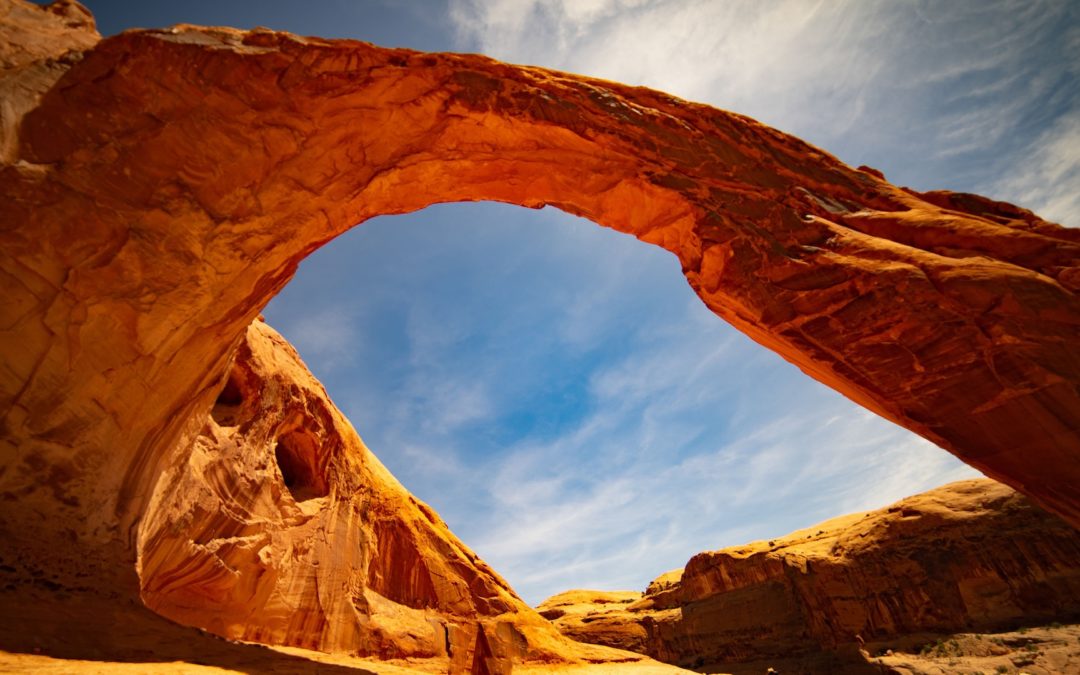
by The Goat | Aug 27, 2019 | Arches, Bryce Canyon, Canyonlands, History, National Parks, Utah Canyon Country, Zion
What are the 5 National Parks in Utah?
Breathe in, breathe out. Survey the scene. Take it all in. This is the most outrageous scenery anywhere in the world, and you are right in the middle of it. Utah’s Canyon Country is a geological fantasy, and an adventure hikers dream. In this wild land there are five National Parks, each of them holding distinction as some of the most iconic on the planet. Zion, Bryce, Capitol Reef, Arches, and Canyonlands National Parks hold some of the most world famous scenery, whimsical geology, and thrilling adventure that people from all over the world flock to, and The Goat is here to give you a first-hand glimpse of what to expect when spelunking Utah’s Canyon Country.
Arches National Park, Northeast Utah near Moab
Arches National Park is perhaps the most famous place in the world. Although that is an incredibly bold statement, there is nothing that represents the Colorado Plateau, the Southwest, and indeed, The United States, quite like an image from Arches. Delicate Arch, pictured above, is without a doubt the most famous natural arch in the world, and is one of the most famous and photographed destinations in the southwest. Quick, think of an image that represents America. We dare you to conjure an image, or series of images, that does not include these iconic features and their namesake National Park.
Established in 1929 as a National Monument by Herbert Hoover then upgraded to a National Park by Richard Nixon in 1969, Arches National Park is home to the largest and densest concentration of sedimentary arches in the world. The literally thousands of arches are among several geologic features that are unique and specific to Arches National Park, and it is markedly different from its neighbor Canyonlands National Park just to the southwest. Arches is set atop a massive salt deposit laid down by an ancient sea roughly 300 million years ago, and this is the special ingredient that has allowed for the fabulous features for which it is most famous.
Set in Utah’s high desert climate, weather in Arches is punctuated by hot summers, mild winters, and seasonal monsoons that can dump most of its 10 inches of yearly precipitation in just a few events. The weather is also one of the root causes for the park’s unique geology, as the unpredictable nature of precipitation, freezing, lake of competent soils, and other factors contribute daily to shape this wondrous piece of the Colorado Plateau.
Check out our Guided Geology Tours of Arches National Park
Bryce Canyon National Park, Southwest Utah near St. George
Fun Fact #1 about Bryce Canyon: It’s not a canyon (bet you didn’t see that coming). Geologically speaking, Bryce Canyon and Bryce Canyon National Park is a natural amphitheater, carved out by millions of years of the erosion of the soft lacustrine (lake) sediments. The most famous feature of the park, its “hoodoos”, are carved out of the Claron Formation, otherwise known as the beautiful pink and orange sandy limestone that caps the entire park. Want to make a few new friends? Hug a hoodoo!
Southwestern Utah, wherein Bryce Canyon National Park is located, is a fundamentally unique and spectacular geologic marvel. Here you will stand in awe as you see the underpinnings of the meetings of two geologic provinces and the forces that shape them both. The Colorado Plateau and the Basin and Range provinces come together in this general region, making Utah’s High Plateau Country what it is; high plateaus that are former mountains that have been acted upon by millions of years of erosion by wind and water.
Faults to the west and east, remnants of the forces that built the Rocky Mountains, have thrust southwestern Utah skyward creating unique topography that is of nearly ridiculous proportions. Bryce Canyon sits at an average elevation of over 8,000 feet, which is quite astonishing considering that it is over 1,000 feet higher than its neighbor Zion National Park. When you think of Bryce Canyon, do you think of elevations higher than average elevations in the Appalachian Mountains? Most don’t, so you’re not alone!
Summer is a great time to visit Bryce Canyon National Park, although that is when the park sees most of its nearly 2.5 million yearly visitors. Winter brings snow and cooler temperatures, though it can lend fantastic solitude to the masterful scenery. Spring and fall can bring unpredictable weather events including snow and rain, but don’t let that stop you, the shoulder seasons are likely the ideal time to visit, as you will avoid winter chill and summer crowds, a rare duel threat.
For more information about Bryce Canyon National Park, give us a call or reserve a spot on one of our fantastic guided Utah geology hiking tours!
Canyonlands National Park, Northeast Utah near Moab
The name of this spectacular National Park says it all; it is truly a land of canyons. Set aside as a National Monument in 1964, Canyonlands National Park contains some of the most awe-inspiring and remote Colorado Plateau scenery that one can find. Telling a geologic story nearly 350 million years old, Canyonlands retains all the features that make it a master class in Colorado Plateau geology and all of Utah’s Mighty 5 National Parks. Here you will find numerous sandstone arches, hoodoos, remote slot canyons, towering cliffs and mesas, faults, folds, salt domes, meteorite impacts, and a collection of some of the most important rock layers of the Paradox Basin, a fundamentally important piece of the geologic puzzle on the Colorado Plateau.
More remote and less-visited than its across-the-highway neighbor Arches National Park, Canyonlands is a place where you feel truly connected to nature, the past, present, and even the future; it’s a place where one can truly ponder the beauty, grace, complexity and its diametric simplicity of the Colorado Plateau in all of its unabashed glory. It holds the confluence of perhaps the West’s two most important rivers; the Colorado and the Green, each of which, along with their tributaries has intricately carved this vast land of seemingly endless gashes in the Earth, each more spectacular and foreboding than the last. Time here has painted, carved, woven, and stitched together the very fabric of what makes Utah and the southwest such an alluring place, and Canyonlands National Park is an absolute forget-about-it must for any outdoor adventurer.
Capitol Reef National Park, Central Utah near Boulder
Perhaps the most underrated National Park in the entire system, and certainly in Utah, is Capitol Reef National Park. Capitol Reef is akin to the forgotten middle child who is class valedictorian, goes to an Ivy League school, becomes a cutting-edge neurosurgeon, and nobody notices. Anyone who knows this middle child would tell you of its brilliance, its beauty, its allure, and its potential. However, not enough people have paid attention because all of its other siblings happen to be smart, beautiful, famous, and in-demand as well.
Born into National Park designation in 1970, Capitol Reef National Park is a veritable outdoor geology laboratory. The wilderness protects a 100-mile long monocline known as The Waterpocket Fold, so names due to the many erosional pockets which house water after rain events. The structure is a towering reminder of the tectonic forces that built the Rocky Moutains, and is one of the most well-exposed, spectacular, largest, and well-preserved (not eroded) such structures on Earth. Along its rugged spine are towering cliffs and mesas that take the form of domes that are reminiscent of capitol buildings found in Washington DC among other big cities, giving their moniker to this wonderful place. The reef portion of the park’s name comes from the foreboding cliffs that seem to guard its secrets, as reefs are commonly known as barriers to travel.
Capitol Reef has many advantages that its sibling parks lack; the best of all being solitude and proximity to large metropolitan areas. Capitol Reef National Park is, quite literally, in the middle of nowhere. Whereas Zion and Bryce are but 2-3 hours from Las Vegas and large highways, and Arches/Canyonlands are just outside of the world-renowned tourist mecca of Moab, Capitol Reef’s largest, nearest city is Boulder; population: 3,500.
No major highways allow easy access, and just getting to Capitol Reef is half the fun, as an approach from any direction takes you into the heart of Utah’s Canyon Country. In addition, it shares its southern border with Grand-Staircase Escalante National Monument, making access from that direction even more adventurous. Some of the most unspoiled wilderness, star-gazing, hiking, and outdoor recreation opportunities are contained within this utterly spectacular and outstanding slice of outdoor heaven. Consider yourself warned.
For more information about Capitol Reef National Park, give us a call or reserve a spot on one of our fantastic guided Utah geology hiking tours!
Zion National Park, Southwest Utah near St. George
Considered by many to be one of the premier National Parks not just in the United States but in the world, Zion National Park ranks as the 6th-most visited National Park in the system. Within its borders are contained some of the most iconic and famous trails and landmarks in the southwest, including Angel’s Landing, The Subway, and The Watchtower to name a few. Despite its visitation numbers, the crowds typically flock to the most well-known parts of the park, and there is plenty of solitude to be found in Zion’s remote and beautiful backcountry.
Located south of Bryce Canyon in Utah’s High Plateau Country, Zion is a wonderful melange of geologic layercake that makes the Colorado Plateau famous. At almost 7,000 feet average elevation, Zion is a land of deeply-eroded canyons, towering cliffs, and is often referred to as “Yosemite Dressed in Red” by it many adoring fans. The Virgin River, which is ultimately the forming body in Lake Mead east of Las Vegas, is also the primary erosional force at work in Zion National Park, and it along with is tributaries have cut into the sunset-red rocks to sculpt Zion’s outrageous and almost daunting scenery.
When to Visit
Summer serves as the park’s busy visitation season with consistent temperatures, stable weather, and ample vacation time for families. However, Zion can be enjoyed year-round, and the hearty outdoor adventure traveler will enjoy the relative solitude offered in the cooler months between October and May.
With so many great adventures to be had, choosing the right one for you can be the hardest part! Give us a call for information about any of these wonderful places, or reserve a spot on one of our fabulous tours and let our expert geologist/guides take you on an epic journey!
Going Guided
Hiking and exploring Utah and its National Parks, is a special experience. Although it is possible to see these places yourself, hiring a guide is a great idea. For instance, guiding services provide logistical support, and plan everything for your best possible trip. They provide a great safety net on the trail, and are trained in backcountry medicine. Above all, they provide a depth of knowledge of the region that turns a walk into a true adventure.
Blue Marble Adventure GeoTourism provides all of the support you need, and pairs that with expert geologist/guides. Our backcountry meals use fresh ingredients, and are planned by a professional chef. Furthermore, we provide top-of-the-line gear and passion for the places we explore. In conclusion, you can visit National Parks, but going with a guide can create and even more memorable experience. Don’t be shy, and call us!
Read our blog!
For adventure hiking vacations in a geologic time machine, see our epic tours in Grand Canyon, Utah, and Arizona!
For geological musings read The Goat’s geology blog.
Follow us on Facebookand Instagram
Explore Further, Be Wild, See Through Time — Blue Marble Adventure GeoTourism
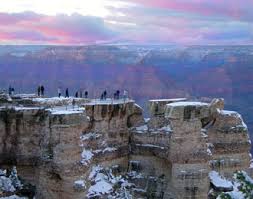
by The Goat | Aug 27, 2019 | Grand Canyon, Hiking
Top 5 Reasons to Visit Grand Canyon in the Winter
Planning a winter getaway? Think that hitting some great trails, seeing ridiculous scenery, and checking things off the bucket list is a summer-only kind of gig? Think again. The cooler months in Grand Canyon provide some of the best opportunities to explore everything that it has to offer, and not have to fight the crowds to do it. The Goat gives you some quite convincing reasons why visiting Grand Canyon during the winter is an idea that seasoned travelers know is the veteran adventure travelers move.
1. The weather is fantastic
While summer in Grand Canyon is pleasant at the rim, going below the rim is best done very early in the day to avoid midday temperatures that can exceed 100 degrees, even at places like Indian Gardens. Thinking of a summer rim-to-river-backpacking trip? Bag that idea right now. Summer in the Inner Gorge is the stuff of Dante’s Inferno, and temperatures during the day can reach well over 120 degrees in the sun.
Travel smart and do your below-the-rim adventures in the cooler months of October-April, where you may get some chills and even snow on the rim, but down in the Canyon will be some of the best hiking weather you can imagine, with sunny temperatures in the mid 50s and 60s, which any canyoneer will tell you is just perfect. These temps also mean that you don’t need to start your below-the-rim hike in Grand Canyon at 3am, which is pleasant news for most of us, even The Goat
2. The crowds are thin
Of the Grand Canyon’s 6 million visitors in 2016, over half (3.2 million) visited between May and August. That’s a whole lot of people in a short amount of time. The Grand Canyon still exists in the other 8 months of the year, and that’s when you, the expert adventure traveler, wants to come. Enjoy the dramatic views, take all the photos, create all the memories, all without having to fight for every inch during Grand Canyon’s busy summer season, and that’s just at the most popular places on the rim. For those looking to venture below the rim, there’s a good chance you will have most trails all to yourself for potentially miles at a time, especially during the week.
3. Few things are more spectacular than snow in Grand Canyon
Ever seen fresh snowfall grace the orange, purple, red, and cream rocks of Grand Canyon? If not, then you owe it to yourself to do so. Some of the most spectacular scenes in The Canyon are made all that more so when dusted by a few inches of the white stuff. Grand Canyon’s South Rim stands at over 7,000 feet elevation, which means we get plenty of snow here during the winter months. So grab a camera and throw on some snowshoes, winter photos at Grand Canyon are as rewarding as they are spectacular.
4. Permits are much easier to come by
Did we mention the crowds (or lack thereof)? This has a wonderful trickle-down effect for people looking to snag those hard-to-come-by permits for life-list trips. Got shut out of Phantom Ranch? Denied on the Hermit Trail? Shot down on your rim-to-rim? The winter months are perfect time to try for those popular permits, and you have a much better chance of securing the permits for that bucket-list Grand Canyon backpacking adventure November-February.
5. Excellent off-season lodging rates and open campsites
Yet another desirable trickle-down of the lack of crowds is that Xanterra, the corporation that manages many of the accommodations in National Parks including Yosemite, Yellowstone, and Grand Canyon try to lure off-season business by offering deeply discounted rates, particularly if you are wanting to stay more than one or two nights. Grand Canyon’s world-class and historic El Tovar, one of the premier accommodations in the National Park system, is typically booked solid through summer several months in advance. However, there are almost always rooms available in the cooler months. Check out Grand Canyon’s website for information on El Tovar and other lodging opportunities during the off-season.
For the more adventurous, Grand Canyon’s developed campgrounds such as Mather Campground see much less traffic in the off-season. Though it may be for good reason, those with the right gear and appetite will find these campgrounds almost wholly deserted during the winter months. There is nothing quite like sipping a warm beverage whilst watching the sun slip down over Grand Canyon’s horizon right from your camp chair, and having nobody but the birds sharing it with you.
Bonus: Shorter days means later sunrise, earlier sunset
For the photographically-inclined hiker, you know that the best light for photos is early in the morning and in the evenings, when the harsh rays of midday have given way to softer hues and myriad colors. The great news during the cooler months in Grand Canyon is that sunrise comes much later, and sunset comes much earlier, giving you more time to devote to your next great shot and less time chasing sunrises at 4am and sunsets at 9pm in the summer.
For more information about traveling to Grand Canyon, give us a call or reserve a spot on one of our guided geology hiking tours and let our geologist/guides walk you through 1.8 billion years of Earth’s fascinating history!
Going Guided
Hiking and exploring Grand Canyon, or any of the National Parks, is a special experience. Although it is possible to see these places yourself, hiring a guide is a great idea. For instance, guiding services provide logistical support, and plan everything for your best possible trip. They provide a great safety net on the trail, and are trained in backcountry medicine. Above all, they provide a depth of knowledge of the region that turns a walk into a true adventure.
Blue Marble Adventure GeoTourism provides all of the support you need, and pairs that with expert geologist/guides. Our backcountry meals use fresh ingredients, and are planned by a professional chef. Furthermore, we provide top-of-the-line gear and passion for the places we explore. In conclusion, you can visit National Parks, but going with a guide can create and even more memorable experience. Don’t be shy, and call us!
Read our blog!
For adventure hiking vacations in a geologic time machine, see our epic tours in Grand Canyon, Utah, and Arizona!
For geological musings read The Goat’s geology blog.
Follow us on Facebookand Instagram
Explore Further, Be Wild, See Through Time — Blue Marble Adventure GeoTourism
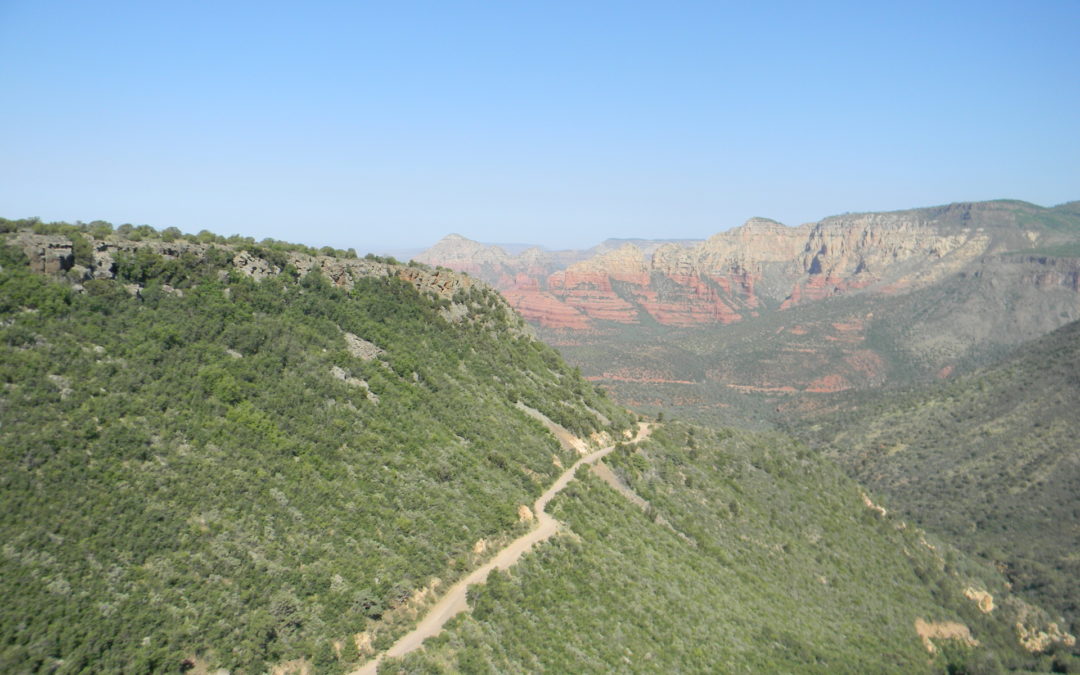
by The Goat | Aug 27, 2019 | Hiking
Top 5 Reasons to Visit Sedona in the Winter
Perhaps the best-kept locals secret in Sedona is the Red Rock Winter Wonderland. When the rest of the northern part of our beautiful state is covered in snow, Sedona continues to boast fabulous sunshine, comfortable temperatures, and grand adventure opportunities. Snow only adds to the splendor, as the gorgeous red rocks get dusted with the wonderfully white snow that contrasts the sunset red and orange that makes Sedona famous. Add crisp blue skies, world-class hiking and winter mountain biking, and what you have is the perfect winter getaway. We’ll offer up 5 reasons why Sedona is the place to be when the weather gets brisk.
1. The weather is perfect
While summertime temperatures can often be quite warm, winter offers daytime temps in the 60s and 70s, perfect for hiking, mountain biking, or any outdoor exploration adventure. Hiking trails that are typically bathed in summer heat turn into absolutely perfect places to enjoy the newly perpetually sunny skies that make Sedona so grand.
2. But it’s also roaring fireside and warm drinks season
There are few things better in life than a scenic daytime adventure followed by a cozy night by the fire. This can be achieved both in Sedona’s fabulous backcountry, or its very tourist-friendly front country. Temperatures are very comfortable during the day, but it can chill down a bit at night, making a roaring fire and a hot choice beverage a great way to end any daily adventure. Plan a great Sedona winter backpacking trip for roaring campfires, or check out any of Sedona’s world-class hotels, some of which make it a point to serve fireside cocoa and s’mores (Sedona Real Inn & Suites and Amara Resort do it up right).
3. The summer crowds are a season away
Winter is actually the off-season for many of Sedona’s hotels, restaurants, and tour companies. This works well to your advantage, as it gives you the ability to enjoy many of Sedona’s greatest attractions without having to fight the crowds that inevitably flock here during the summer months. This is a perfect time for a guided hiking tour!
4. Romance is in the air
Among the many reasons that couples of all ages visit Sedona is that it is routinely being named among America’s Most Romantic Winter Destinations. In fact, Travel and Leisure Magazine just named it among the top 10 in the country, along with such destinations as Hawaii, New York City, Palm Springs, and Jackson Hole, Wyoming, putting Sedona among the premier couple destinations not just in the country, but perhaps the world. Couples traveling to Sedona will find that having world-class hiking, dining, and scenery all to themselves is just about as fire-stoking as it gets.
5. There is so much to do!
Sedona is a doers’ paradise, with something happening in town almost every day. As mentioned, of course, are the hundreds of miles of outstanding hiking and biking trails, but those are not necessarily on the calendar. In fact, winter mountain biking in Sedona is a sought-after tradition for mountain bikers throughout the world!
In addition, visitors can enjoy the Sedona Yoga Festival, The Red Rock Marathon, and The Sedona International Film Festival and Workshop think less crazy Sundance or Cannes) just to name a few. And, as always, our geologist/guidesare ready to take you on a time travel adventure unlike any in the world!
Sedona is a can’t miss destination for those of you yearning for world-class winter adventure, and you can do it here without fighting the crowds, the snow, or the peak-season prices (that’s right, winter=discounts)!
Going Guided
Hiking and exploring Sedona is a special experience. Although it is possible to see these places yourself, hiring a guide is a great idea. For instance, guiding services provide logistical support, and plan everything for your best possible trip. They provide a great safety net on the trail, and are trained in backcountry medicine. Above all, they provide a depth of knowledge of the region that turns a walk into a true adventure.
Blue Marble Adventure GeoTourism provides all of the support you need, and pairs that with expert geologist/guides. Our backcountry meals use fresh ingredients, and are planned by a professional chef. Furthermore, we provide top-of-the-line gear and passion for the places we explore. In conclusion, you can visit National Parks, but going with a guide can create and even more memorable experience. Don’t be shy, and call us!
Read our blog!
For adventure hiking vacations in a geologic time machine, see our epic tours in Grand Canyon, Utah, and Arizona!
For geological musings read The Goat’s geology blog.
Follow us on Facebookand Instagram
Explore Further, Be Wild, See Through Time — Blue Marble Adventure GeoTourism

by The Goat | Aug 27, 2019 | Hiking, Sedona
Top 5 Hikes in Sedona
Sedona: The very mention conjures up blazing red rock sunsets, towering spires, monolithic cathedrals, and inspiring zen. Another phrase the word Sedona should conjure in your mind is this: world-class hiking. Sedona’s hundreds of miles of wilderness trails presents some of the most excellent hiking in the American Southwest, with sweeping iconic red rock vistas, wildlife, and, if you know where to look, relaxing and fulfilling solitude. Sedona’s hiking trails are also, of course, an excellent place to view the ebb and flow of ancient seas along the Pangean coastline many millions of years ago, making it of very special interest to Blue Marble’s Goat. Here, we have prepared for your hiking pleasure The Goat’s Top 5 Sedona Hiking Adventures. See you on the trail!
5. Bear Mountain, Red Rock-Secret Canyon Wilderness, Sedona
Bear Mountain, one of Sedona’s highest peaks at 6506 ft above sea level, is also one of Sedona’s most spectacular hikes. In addition, given that it is one of the more challenging and rugged trails, it is one of the least populated, as people opt for Red Rock Country’s easier trails. This is excellent news for you, because the reward for hiking the Bear Mountain Trail are some of the most spectacular views Sedona has to offer, which we don’t have to tell you means something. This is also a perfect hike in the cooler months, as the southern aspect and lack of shade maintains warm temperatures in the fall, winter, and spring. From the summit of this red rock monolith, all ten of Sedona’s stratigraphic layers can be seen and counted, making it of special importance to The Goat.
4. Secret Canyon, Red Rock-Secret Canyon Wilderness, Sedona
Secret Canyon is perhaps the quintessential Sedona hiking adventure. This popular trail into its namesake Red Rock-Scret Canyon Wilderness contains some of the most natural beauty of any hike in Sedona, with a cool stream, shade, excellent wildlife-viewing opportunities, fabulous rock formations, and an intimate Sedona canyon experience. What is most special about Secret Canyon, however, is that it is nearly as long, and perhaps even more beautiful than its more famous and populated neighbor Oak Creek Canyon. In any case, Secret Canyon is a tremendous hiking adventure in Sedona, and a wonderful introduction to Red Rock Country.
3. Wilson Mountain, Red Rock-Secret Mountain Wilderness, Sedona
The highest peak in Sedona at over 7100 feet above sea level, Wilson Mountains reigns supreme for sweeping views of Sedona and beyond. Excellent for hikers that are looking for more of a challenge, Wilson Mountain offers a rugged and adventurous trail that is a fabulous hike in the cooler months of the year. At the summit, the hiker is treated to dramatic views of Sedona Red Rock Country, Oak Creek Canyon, the Mogollon Rim, and on a clear day, all the way to the San Francisco Peaks north of Flagstaff.
2. Boynton Canyon, Red Rock-Secret Mountain Wilderness, Sedona
Boynton Canyon offers up one of the most spectacular canyon hiking experiences in the southwest, with towering red rock spires, buttes, mesas, and even a chance at wonderful solitude. Rock climbers particularly are interested in this beautiful trail, as many of the rock formations here lend an opportunity for some epic routes up the soaring red rocks. For the hiker however, Boynton Canyon is a special place in Sedona, as it is far enough removed from the town and its tourist traps that include the most popular trails, yet close enough to be reached in not much more time than it takes to reach some of the more popular destinations. Goat approved!
1. Loy Canyon, Red Rock-Secret Canyon Wilderness, Sedona
Loy Canyon earns our #1 ranking for one simple reason: diversity. Loy Canyon provides a unique Sedona canyon hiking experience that is unmatched in our humble opinion, with solitude, shade, expansive views down the canyon, and opportunities for excellent overnight trips and trail connecting. After a climb to the base of Secret Mountain, views into Loy Canyon are wide and dramatic, particularly in the morning and evening as soft light bathes the fiery red rocks and creamy sandstones that make Sedona famous. Don’t miss this one!
So there we have it, The Goat’s Top 5 Sedona Day Hikes. You can tackle these wonderful trails yourself, or enhance your experience with one of our fabulous geologist/guides who will let you in on all of Sedona’s secrets. See you on the trail!
Going Guided
Hiking and exploring Sedona is a special experience. Although it is possible to see these places yourself, hiring a guide is a great idea. For instance, guiding services provide logistical support, and plan everything for your best possible trip. They provide a great safety net on the trail, and are trained in backcountry medicine. Above all, they provide a depth of knowledge of the region that turns a walk into a true adventure.
Blue Marble Adventure GeoTourism provides all of the support you need, and pairs that with expert geologist/guides. Our backcountry meals use fresh ingredients, and are planned by a professional chef. Furthermore, we provide top-of-the-line gear and passion for the places we explore. In conclusion, you can visit National Parks, but going with a guide can create and even more memorable experience. Don’t be shy, and call us!
Read our blog!
For adventure hiking vacations in a geologic time machine, see our epic tours in Grand Canyon, Utah, and Arizona!
For geological musings read The Goat’s geology blog.
Follow us on Facebookand Instagram
Explore Further, Be Wild, See Through Time — Blue Marble Adventure GeoTourism


